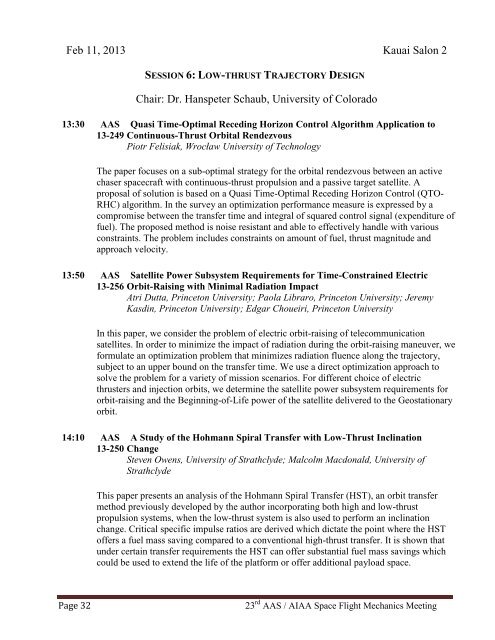meetings - Space Flight Mechanics Committee
meetings - Space Flight Mechanics Committee
meetings - Space Flight Mechanics Committee
Create successful ePaper yourself
Turn your PDF publications into a flip-book with our unique Google optimized e-Paper software.
Feb 11, 2013 Kauai Salon 2<br />
SESSION 6: LOW-THRUST TRAJECTORY DESIGN<br />
Chair: Dr. Hanspeter Schaub, University of Colorado<br />
13:30 AAS Quasi Time-Optimal Receding Horizon Control Algorithm Application to<br />
13-249 Continuous-Thrust Orbital Rendezvous<br />
Piotr Felisiak, Wrocław University of Technology<br />
The paper focuses on a sub-optimal strategy for the orbital rendezvous between an active<br />
chaser spacecraft with continuous-thrust propulsion and a passive target satellite. A<br />
proposal of solution is based on a Quasi Time-Optimal Receding Horizon Control (QTO-<br />
RHC) algorithm. In the survey an optimization performance measure is expressed by a<br />
compromise between the transfer time and integral of squared control signal (expenditure of<br />
fuel). The proposed method is noise resistant and able to effectively handle with various<br />
constraints. The problem includes constraints on amount of fuel, thrust magnitude and<br />
approach velocity.<br />
13:50 AAS Satellite Power Subsystem Requirements for Time-Constrained Electric<br />
13-256 Orbit-Raising with Minimal Radiation Impact<br />
Atri Dutta, Princeton University; Paola Libraro, Princeton University; Jeremy<br />
Kasdin, Princeton University; Edgar Choueiri, Princeton University<br />
In this paper, we consider the problem of electric orbit-raising of telecommunication<br />
satellites. In order to minimize the impact of radiation during the orbit-raising maneuver, we<br />
formulate an optimization problem that minimizes radiation fluence along the trajectory,<br />
subject to an upper bound on the transfer time. We use a direct optimization approach to<br />
solve the problem for a variety of mission scenarios. For different choice of electric<br />
thrusters and injection orbits, we determine the satellite power subsystem requirements for<br />
orbit-raising and the Beginning-of-Life power of the satellite delivered to the Geostationary<br />
orbit.<br />
14:10 AAS A Study of the Hohmann Spiral Transfer with Low-Thrust Inclination<br />
13-250 Change<br />
Steven Owens, University of Strathclyde; Malcolm Macdonald, University of<br />
Strathclyde<br />
This paper presents an analysis of the Hohmann Spiral Transfer (HST), an orbit transfer<br />
method previously developed by the author incorporating both high and low-thrust<br />
propulsion systems, when the low-thrust system is also used to perform an inclination<br />
change. Critical specific impulse ratios are derived which dictate the point where the HST<br />
offers a fuel mass saving compared to a conventional high-thrust transfer. It is shown that<br />
under certain transfer requirements the HST can offer substantial fuel mass savings which<br />
could be used to extend the life of the platform or offer additional payload space.<br />
Page 32<br />
23 rd AAS / AIAA <strong>Space</strong> <strong>Flight</strong> <strong>Mechanics</strong> Meeting
















